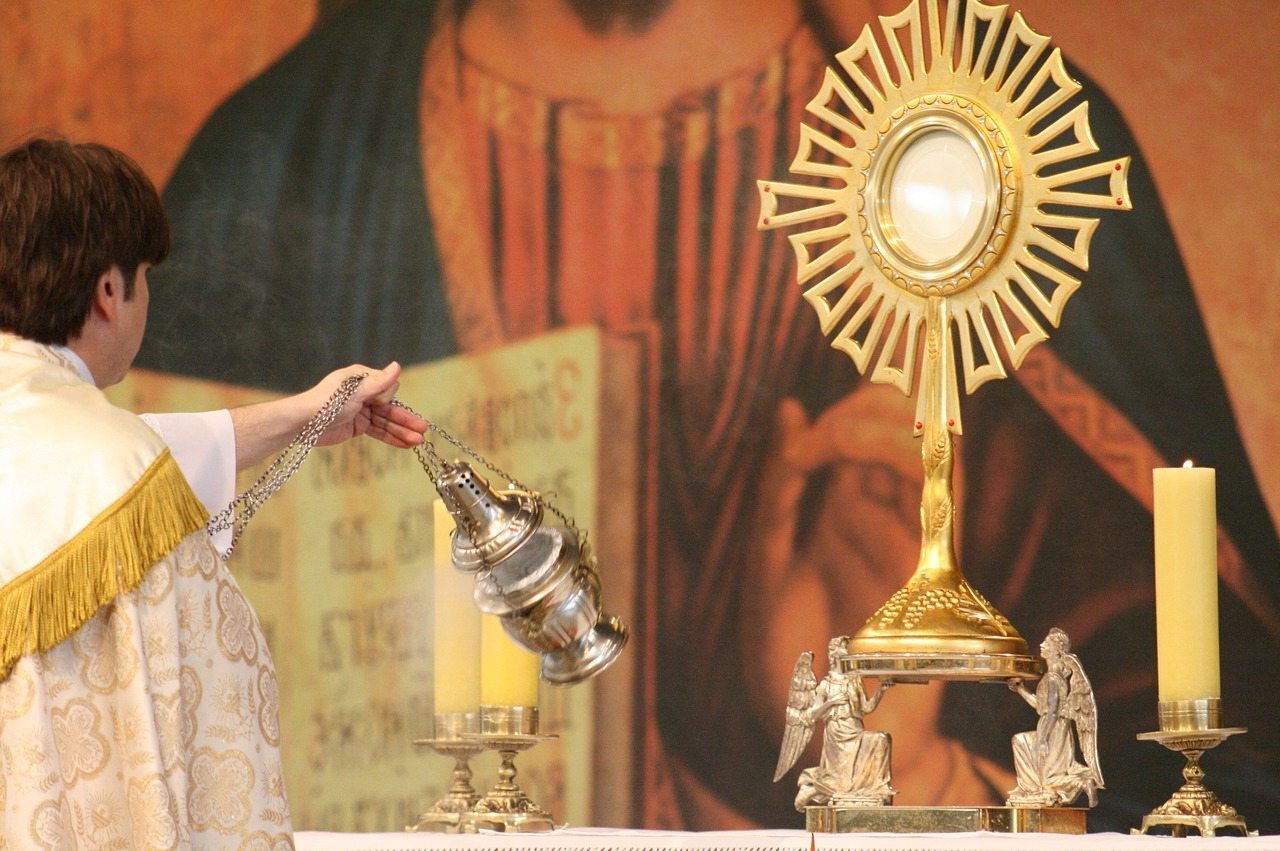
Transubstantiation is a central belief in the Roman Catholic Church, asserting that during the Eucharist, the bread and wine become the actual body and blood of Jesus Christ. This transformation, known as the Real Presence, occurs during the consecration in the Mass. Rooted in early Christian tradition, the doctrine was formally defined by the Council of Trent in the 16th century. While the bread and wine retain their outward appearances, their essence changes completely. This belief is supported by specific biblical passages and has been explained using Aristotelian philosophy. Despite its complexity, transubstantiation remains a cornerstone of Catholic faith and practice.
What is Transubstantiation?
Transubstantiation is a central belief in Roman Catholic theology. It holds that during the Eucharist, the bread and wine become the actual body and blood of Jesus Christ. This transformation is profound and mysterious, rooted in centuries of tradition and scripture.
- Definition of Transubstantiation: The bread and wine change into the Body and Blood of Christ during the Mass.
- Historical Context: The early Christian Church laid the groundwork for this belief, with significant moments like the Council of Ephesus in 431 AD.
- Middle Ages and Scholasticism: Theologians like Thomas Aquinas used Aristotelian concepts to explain this transformation.
- Council of Trent: This council (1545-1563) formally defined transubstantiation as a doctrine of the Catholic Church.
- Scriptural Basis: Passages like John 6:32-58 and Matthew 26:26 support this belief.
Theological Underpinnings
Understanding transubstantiation involves diving into complex theological concepts. These ideas help explain how the bread and wine can become Christ's body and blood while retaining their original appearances.
- Aristotelian Terminology: "Substance" refers to an object's deepest reality, while "accidents" are its outward appearances.
- Change of Substance vs. Accidents: The substance changes, but the accidents (taste, smell, appearance) remain the same.
- Eucharistic Presence: This doctrine affirms the Real Presence of Christ in the Eucharist, not just symbolically.
- Consecration Process: A priest performs the consecration during Mass, transforming the bread and wine.
- Catholic Catechism: Section 1376 of the Catechism defines transubstantiation.
Protestant Rejection and Alternative Views
Not all Christian denominations accept transubstantiation. Many Protestant groups interpret the Eucharist differently, leading to significant theological debates.
- Protestant Rejection: Many Protestant denominations view the Eucharist as a memorial rather than a literal transformation.
- Eucharistic Theology: This theology emphasizes Christ's presence in each part of the Eucharist.
- Multilocation: Catholics believe God can make any object present in multiple locations simultaneously.
- Annihilation of Matter: God can cause matter to return to nothing, essential for understanding transubstantiation.
- Scriptural Interpretation: Catholics interpret Jesus' words in John 6:51-58 literally.
Eucharistic Sacrifice and Spiritual Life
The Eucharist is more than a ritual; it's a profound spiritual experience. It connects believers to Christ's sacrifice and offers spiritual nourishment.
- Eucharistic Sacrifice: Some see transubstantiation as a re-sacrifice of Jesus, though Scripture states He died once for all.
- Hebrews 7:27: This passage emphasizes the uniqueness of Christ's sacrifice.
- Eucharistic Meal: The Eucharist is a real meal where Christ's body and blood are consumed.
- Spiritual vs. Physical: Jesus' words in John 6:63 clarify that His words are spiritual.
- Symbolic vs. Literal: Catholics interpret Jesus' words in John 6:53-57 literally, while Protestants often see them symbolically.
Modern Debates and Interpretations
In today's world, the doctrine of transubstantiation continues to spark debate. Some question the use of ancient philosophical concepts, while others seek new ways to explain this mystery.
- Eucharistic Theology in the 21st Century: Using Aristotelian concepts to explain Catholic mysteries is debated.
- Alternative Explanations: Some suggest explaining transubstantiation without using "substance" and "accidents."
- Eucharistic Presence in Each Species: Christ is present whole and entire in each part of the Eucharist.
- Daily Spiritual Radiation: Catholics believe in a daily spiritual change during Mass.
- Time and Transubstantiation: God's grace washes across all time, past and future.
Unusual Examples and Reactions
Sometimes, unusual examples and reactions highlight the mystery of transubstantiation. These stories illustrate the profound impact of this belief.
- Nuclear Experimentation: An unconsecrated host exposed to radiation remained unchanged in appearance, highlighting the spiritual nature of transubstantiation.
- Heretic's Reaction: A heretic was alarmed when presented with a consecrated host, realizing the profound change despite no visible difference.
- Catholic Faith and Doubt: Catholics trust Jesus' words about being the living bread from Heaven.
- Scriptural Context: Jesus' words in John 6:53-57 were hard for many, leading some to desert Him.
- Theological Debate: The use of Aristotelian concepts to explain transubstantiation remains debated.
Tradition and Consistency
Transubstantiation is deeply rooted in Catholic tradition. This consistency over centuries underscores its importance in Catholic faith and practice.
- Eucharistic Theology and Tradition: The doctrine has been part of Catholic Tradition since the early Church.
- Scriptural Interpretation in History: Catholics have consistently interpreted Jesus' words in John 6:51-58 literally.
- Protestant Reformation and Transubstantiation: The doctrine was a major point of contention during the Reformation.
- Catholic Response to Rejection: Catholics argue their interpretation is supported by Tradition and Scripture.
- Eucharistic Sacrifice and Scripture: The idea of a re-sacrifice contradicts Scripture, which states Jesus died once for all.
Spiritual Nourishment and Eternal Life
The Eucharist offers spiritual nourishment and a connection to eternal life. This belief is central to Catholic faith and practice.
- Hebrews 7:27 and Transubstantiation: This passage underscores the uniqueness of Christ's sacrifice.
- Eucharistic Meal and Spiritual Life: The Eucharist is a real meal where Christ's body and blood are consumed.
- Symbolic vs. Literal Interpretation: Catholics interpret Jesus' words in John 6:53-57 literally.
- Eucharistic Theology in Modern Times: Using Aristotelian concepts to explain Catholic mysteries is debated.
- Alternative Explanations Without Substance: Some suggest explaining transubstantiation without using "substance" and "accidents."
Daily Practice and Eternal Mystery
Transubstantiation is a daily practice in Catholic Mass, yet it remains an eternal mystery. This belief connects believers to Christ in a profound way.
- Eucharistic Presence in Each Species: Christ is present whole and entire in each part of the Eucharist.
- Daily Spiritual Radiation During Mass: Catholics believe in a daily spiritual change during Mass.
- Time and Transubstantiation: God's grace washes across all time, past and future.
- Nuclear Experimentation and Transubstantiation: An unconsecrated host exposed to radiation remained unchanged in appearance.
- Heretic's Reaction to Transubstantiation: A heretic was alarmed when presented with a consecrated host, realizing the profound change despite no visible difference.
Understanding Transubstantiation
Transubstantiation is a core belief in Catholic theology, asserting that during the Eucharist, bread and wine become the actual body and blood of Jesus Christ. This transformation, rooted in early Christian tradition, was formally defined by the Council of Trent. The doctrine relies on Aristotelian concepts of "substance" and "accidents" to explain how the essence changes while appearances remain the same. Despite Protestant rejection, Catholics hold that scriptural passages like John 6:51-58 support this belief. The Eucharist is seen as more than a memorial; it's a real meal offering spiritual life. While some debate the use of Aristotelian terms, the essence of transubstantiation remains a profound mystery. This belief underscores the Real Presence of Christ in the Eucharist, making it a cornerstone of Catholic faith and practice. Understanding this doctrine offers insight into the depth and richness of Catholic worship.
Was this page helpful?
Our commitment to delivering trustworthy and engaging content is at the heart of what we do. Each fact on our site is contributed by real users like you, bringing a wealth of diverse insights and information. To ensure the highest standards of accuracy and reliability, our dedicated editors meticulously review each submission. This process guarantees that the facts we share are not only fascinating but also credible. Trust in our commitment to quality and authenticity as you explore and learn with us.


